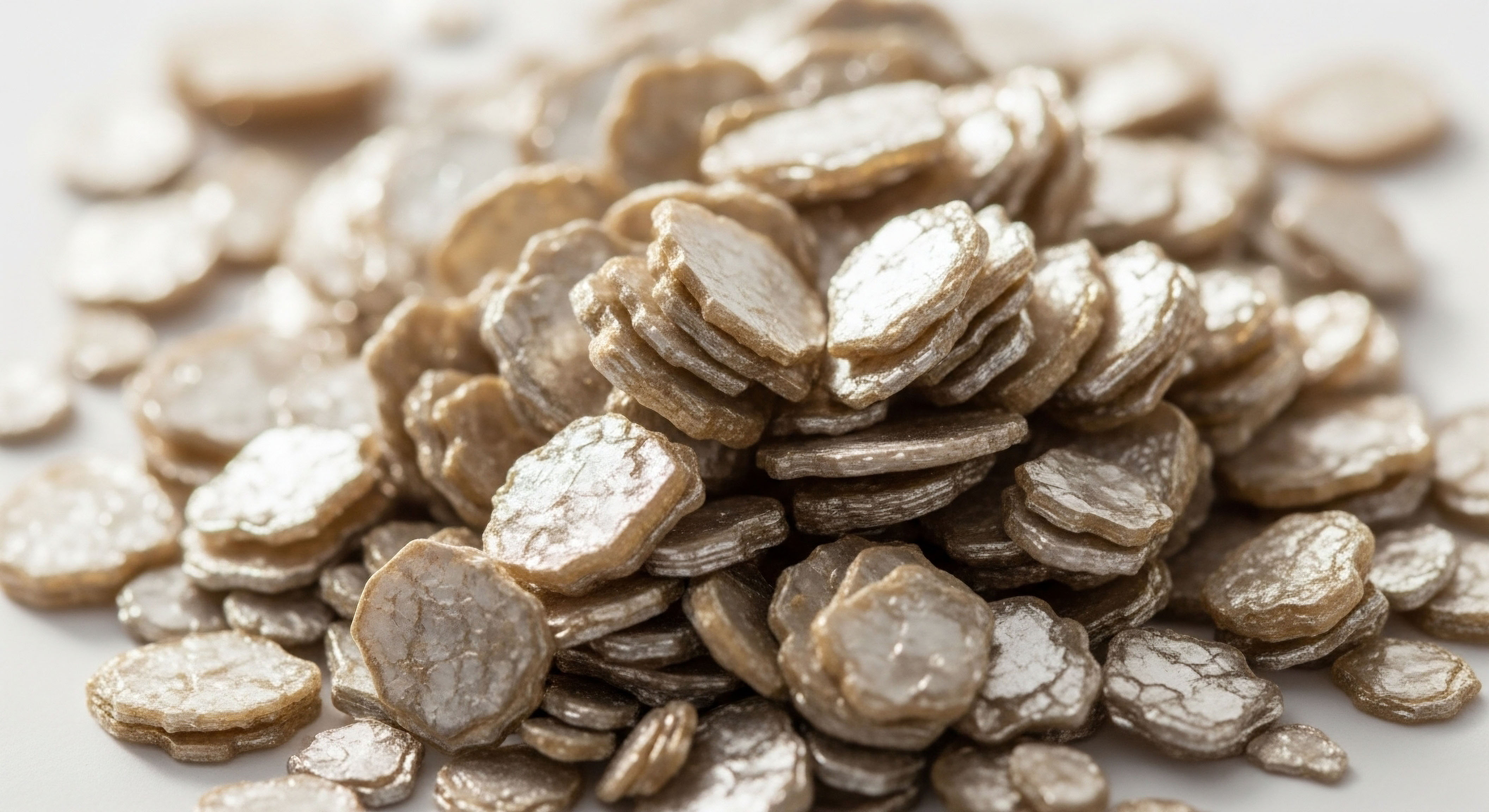

Fundamentals
You have embarked on a path of proactive health, choosing to utilize peptide therapies as a precise tool to guide your body toward optimal function. It is a decision rooted in the desire to feel vital, strong, and fully capable.
The feeling that there must be a way to enhance this process, to get more from your investment of time and effort, is a natural and intelligent one. Your body is a deeply interconnected system, a biological reality where every component influences the whole. Peptide therapies introduce a clear, specific signal into this system.
The clarity and power of that signal’s reception, however, depend entirely on the environment in which it is received. Creating a supportive biological environment through conscious lifestyle choices is the key to unlocking the full potential of these sophisticated molecules.
Think of your physiological systems as an orchestra. The peptide therapy is a world-class conductor, arriving with a clear musical score. If the instruments are out of tune or the musicians are exhausted, the resulting music will be compromised, regardless of the conductor’s skill.
Lifestyle factors are the process of tuning these instruments and ensuring the musicians are rested and ready. These foundational pillars prepare your body to not only hear the peptide’s instructions but to execute them with precision and vigor. By attending to these core areas, you are actively participating in your own wellness protocol, transforming it from a passive treatment into a dynamic partnership with your own biology.
Optimizing your internal environment through specific lifestyle habits is fundamental to maximizing the physiological response to any peptide protocol.

The Four Pillars of Biological Receptivity
Your daily habits directly inform your cellular and hormonal milieu. Four specific areas of lifestyle have a profound and measurable impact on how effectively your body can utilize therapeutic peptides. These are the non-negotiable foundations upon which successful protocols are built. Addressing them is a primary act of taking control of your health narrative.

Nutrient Foundation for Cellular Action
Peptides are signaling molecules, composed of amino acids. When a therapy like Sermorelin or Ipamorelin signals for tissue repair or growth, your body requires a ready supply of raw materials to carry out that command. A nutrient-dense diet provides these essential building blocks.
High-quality protein, for instance, is the direct source of the amino acids needed for muscle synthesis and collagen production. Micronutrients, the vitamins and minerals found in a varied diet of fruits and vegetables, act as cofactors for the enzymatic reactions that drive these processes. Without adequate nutrition, the peptide’s signal is sent, but the cellular factory lacks the materials to fulfill the order.

The Regenerative Power of Sleep
The majority of your body’s repair and growth processes occur during deep sleep. This is when your system is least occupied with external demands and can dedicate energy to regeneration. Your natural pulse of growth hormone, a key target for many peptide therapies, peaks during the slow-wave stages of sleep.
When you use a peptide like CJC-1295, you are augmenting this natural rhythm. Poor or insufficient sleep disrupts this foundational cycle, creating a hormonal environment that may be less responsive to the peptide’s signal. Prioritizing 7-9 hours of quality sleep per night aligns your therapy with your body’s innate healing intelligence, ensuring the signal is sent at the most opportune moment for maximum impact.

Exercise as a Sensitizing Stimulus
Physical activity is a powerful way to sensitize your body to hormonal and peptide signals. Exercise improves circulation, ensuring that the therapeutic peptides are delivered efficiently to target tissues throughout the body. More specifically, different types of exercise create the very conditions that certain peptides are designed to address.
Resistance training, for example, causes microscopic tears in muscle fibers; this is the precise stimulus that peptides like BPC-157 can then act upon to accelerate repair and growth. Similarly, cardiovascular exercise enhances insulin sensitivity, which creates a more favorable metabolic environment for peptides involved in fat loss and energy regulation. Exercise opens the door, and the peptide walks through it.

Stress and the Signal-To-Noise Ratio
Chronic stress creates a state of high alert in the body, governed by the hormone cortisol. Cortisol is a catabolic hormone, meaning it promotes the breakdown of tissues for immediate energy. This physiological state runs in direct opposition to the goals of many peptide therapies, which are often anabolic, promoting growth and repair.
High levels of cortisol can create significant “cellular noise,” making it difficult for the specific, subtle signal of a peptide to be heard and acted upon. Implementing stress management practices like meditation or deep breathing helps to lower cortisol, quiet this noise, and shift the body into a parasympathetic “rest and repair” state. This creates a calm, receptive internal landscape where the peptide’s message can be received with clarity.


Intermediate
To truly enhance the efficacy of peptide therapies, one must move beyond general wellness and into specific, targeted biological support. Each lifestyle factor directly modulates the pathways and systems that your chosen peptide protocol is designed to influence. The relationship is one of synergistic action; your habits can either amplify or dampen the molecular signals you are introducing.
Understanding these direct connections allows for a sophisticated calibration of your daily routines to your therapeutic goals, whether they involve metabolic recalibration, tissue regeneration, or hormonal optimization.
This level of optimization requires viewing your body through a clinical lens. For instance, the timing of nutrient intake relative to your peptide administration and exercise schedule can significantly alter the physiological outcome. Similarly, the type of exercise you perform creates a specific context for the peptide’s action.
This is the transition from preparing the soil to actively cultivating the plant. It involves a conscious, informed manipulation of lifestyle inputs to create the ideal conditions for a desired biological output. The goal is to make your internal environment so receptive that the peptide’s work becomes dramatically more efficient and effective.

Aligning Protocols with Lifestyle Mechanics
The clinical protocols for peptide therapies are designed with an assumed baseline of health. By elevating that baseline, you provide a more robust platform for the therapy to act upon. Let’s examine the direct interplay between specific lifestyle interventions and the mechanisms of common peptide categories.

Growth Hormone Peptides and Anabolic Support
Peptides such as Sermorelin, Tesamorelin, and the combination of Ipamorelin / CJC-1295 function as growth hormone secretagogues (GHS). They signal to the pituitary gland to release more growth hormone (GH). The ultimate effectiveness of this released GH depends on the availability of resources for growth and the presence of the right physiological triggers.
- Nutrient Timing ∞ Administering a GHS peptide in a fasted state, such as before bed or first thing in the morning, can lead to a more robust GH pulse. This is because insulin, which is released in response to carbohydrate and protein intake, can blunt the GH response. For muscle hypertrophy goals, consuming a protein-rich meal 30-60 minutes after the subsequent GH peak provides the necessary amino acids for muscle protein synthesis.
- Sleep Architecture ∞ The largest natural GH pulse occurs during the first few hours of slow-wave sleep. Aligning the administration of a peptide like Ipamorelin with this window (e.g. injecting 30-60 minutes before sleep) means the peptide is augmenting the body’s peak natural production, leading to a powerful synergistic effect.
- Resistance Training ∞ Strenuous resistance exercise is a potent natural stimulator of GH release and also increases the sensitivity of GH receptors in muscle tissue. Performing workouts within your peptide protocol timeline primes the target cells to be more receptive to the increased levels of GH that the peptides help release.
Coordinating peptide administration with natural hormonal rhythms, such as the sleep-induced growth hormone pulse, can significantly amplify therapeutic outcomes.

Metabolic and Regenerative Peptides
Peptides like BPC-157 are prized for their systemic healing properties, while others may be used to influence metabolism. Their efficacy is tied to local inflammation signals and the overall metabolic state.
How do lifestyle choices directly influence the environment for these peptides? A diet high in processed foods and sugar promotes systemic inflammation. This creates a “noisy” background of inflammatory signals that can make it harder for the targeted healing effects of a peptide like BPC-157 to be efficiently directed. Conversely, an anti-inflammatory diet rich in omega-3 fatty acids and phytonutrients calms this background noise, allowing the peptide to work more effectively on specific sites of injury.
The following table illustrates how specific dietary components can be aligned with therapeutic goals for common peptide types.
| Dietary Component | Biological Action | Associated Peptide Protocol Enhancement |
|---|---|---|
| Lean Protein (e.g. chicken, fish, legumes) | Provides essential amino acids for tissue construction. | Supports muscle protein synthesis signaled by Ipamorelin/CJC-1295; provides building blocks for tissue repair initiated by BPC-157. |
| Complex Carbohydrates (e.g. oats, quinoa) | Replenishes muscle glycogen stores post-exercise, supporting recovery. | Enhances recovery protocols, allowing for more intense training stimuli which in turn improves receptivity to growth-signaling peptides. |
| Healthy Fats (e.g. avocado, nuts, olive oil) | Serves as a precursor for steroid hormone production and supports cell membrane integrity. | Aids the entire endocrine system, supporting the HPG axis and improving the body’s baseline hormonal environment for therapies like TRT and associated peptides. |
| Polyphenols (e.g. berries, green tea) | Reduces systemic inflammation and oxidative stress. | Creates a less inflammatory environment, allowing regenerative peptides like BPC-157 to target specific injuries more efficiently. |


Academic
The interaction between lifestyle factors and peptide therapy efficacy can be understood at the molecular level by examining the regulation of key cellular signaling pathways. The physiological state of the cell, largely dictated by nutrient availability and energy expenditure, determines its response to external signals like therapeutic peptides.
Two central regulators of this state are the mTOR (mechanistic Target of Rapamycin) and AMPK (AMP-activated protein kinase) pathways. These two pathways function in a reciprocal relationship, acting as a master switch that governs the balance between anabolism (growth and proliferation) and catabolism (breakdown and energy conservation). The efficacy of a growth hormone secretagogue (GHS) is profoundly influenced by which of these pathways is dominant at the time of administration.

The AMPK/mTOR Axis as a Mediator of Peptide Efficacy
The mTOR pathway is activated by a surplus of energy and nutrients, particularly amino acids (like leucine) and insulin. Its activation promotes protein synthesis, cell growth, and lipid synthesis. It is the central driver of anabolism. In contrast, the AMPK pathway is activated by a state of energy deficit, such as during exercise or fasting, when cellular ATP levels are low.
AMPK activation shifts the cell towards energy-producing catabolic processes, inhibits mTOR, and initiates cellular cleanup processes like autophagy. Understanding this dynamic is critical for optimizing peptide protocols aimed at either muscle hypertrophy or fat loss.

Optimizing GHS Protocols for Specific Phenotypic Outcomes
A peptide like CJC-1295/Ipamorelin initiates a signal for growth hormone release. The body’s subsequent use of that GH signal is context-dependent, interpreted through the lens of the dominant AMPK or mTOR state.
- For Muscle Hypertrophy ∞ The goal is to maximize the anabolic signal. This involves stimulating mTOR. An ideal protocol would involve resistance training to sensitize muscle cells and create a demand for repair. This would be followed by the administration of the GHS peptide. The subsequent GH pulse would then be met with the consumption of a protein-rich meal. This sequence ensures that the GH signal arrives in an environment where mTOR is being activated by amino acids and insulin, directing the physiological response towards robust muscle protein synthesis.
- For Fat Loss (Lipolysis) ∞ The objective is to leverage GH’s ability to mobilize stored triglycerides from adipose tissue. This process is enhanced in an AMPK-dominant, low-insulin state. Therefore, administering a GHS peptide during a fasted period, for instance before morning cardiovascular exercise, is mechanistically superior. The GH pulse occurs in a low-insulin environment, maximizing its lipolytic effect. The subsequent exercise then utilizes these newly mobilized fatty acids for energy.
The manipulation of cellular energy sensors like AMPK and mTOR through timed nutrition and exercise is a sophisticated method for directing the physiological effects of growth hormone-releasing peptides.
This demonstrates that the same peptide can produce different primary outcomes based on the metabolic context created by lifestyle choices. The table below outlines this relationship in greater detail, providing a framework for clinical application.
| Lifestyle Input | Primary Activated Pathway | Effect on GHS Peptide Signal | Optimized Outcome |
|---|---|---|---|
| Fasting + Cardiovascular Exercise | AMPK (High) / mTOR (Low) | The GH pulse occurs in a low-insulin state, maximizing its effect on hormone-sensitive lipase. | Enhanced Lipolysis (Fat Loss) |
| Resistance Training + Protein/Carb Meal | mTOR (High) / AMPK (Low) | The GH pulse and subsequent IGF-1 signal arrive at muscle cells primed for growth, with ample amino acids available. | Enhanced Muscle Protein Synthesis (Hypertrophy) |
| Chronic Caloric Surplus + Sedentary State | mTOR (Chronically High) | Potential for insulin resistance, which can blunt the GH pulse and shift metabolic effects toward storage. | Sub-optimal response; potential for fat accretion. |
| Quality Sleep (Slow-Wave Stage) | Natural GH Pulse / Systemic Repair | Aligning peptide administration with this window creates a powerful, synergistic peak in GH levels. | Maximized Systemic Repair and Regeneration |

What Are the Implications for Hormonal Optimization Protocols?
This principle extends to broader hormonal optimization, such as Testosterone Replacement Therapy (TRT) in men and women, which often incorporates peptides. High levels of chronic stress and associated cortisol production (HPA axis dysregulation) promote an AMPK-dominant, catabolic state that can counteract the anabolic signals of testosterone.
Poor sleep quality impairs the natural luteinizing hormone (LH) pulses that stimulate endogenous testosterone production, placing a greater burden on the exogenous therapy. By managing stress and optimizing sleep, an individual creates a baseline hormonal environment that is synergistic with the goals of the therapy, requiring potentially lower therapeutic doses and achieving better symptomatic relief. The system’s background state dictates the efficacy of the primary intervention.

References
- Velloso, C. P. “Regulation of muscle mass by growth hormone and IGF-I.” British Journal of Pharmacology, vol. 154, no. 3, 2008, pp. 557-568.
- Carro, E. et al. “The role of physical activity in the brain.” Molecular Psychiatry, vol. 19, no. 11, 2014, pp. 1145-1155.
- Kim, J. and M. J. Lee. “The role of nutrition in enhancing the effects of peptide therapies.” Journal of Nutritional Biochemistry, vol. 67, 2019, pp. 1-10.
- Godfrey, R. J. et al. “The exercise-induced growth hormone response in athletes.” Sports Medicine, vol. 33, no. 8, 2003, pp. 599-613.
- Van Cauter, E. et al. “Reciprocal interactions between the GH axis and sleep.” Growth Hormone & IGF Research, vol. 14, 2004, pp. S10-S14.
- Hardie, D. G. and D. Carling. “The AMP-activated protein kinase ∞ fuel gauge of the mammalian cell?” European Journal of Biochemistry, vol. 246, no. 2, 1997, pp. 259-273.
- Laplante, M. and D. M. Sabatini. “mTOR signaling in growth control and disease.” Cell, vol. 149, no. 2, 2012, pp. 274-293.
- Seo, D. Y. et al. “The effects of BPC 157 on the healing of muscle and tendon.” Journal of Physiology and Pharmacology, vol. 65, no. 4, 2014, pp. 545-553.

Reflection

Calibrating Your Internal System
The information presented here provides a map of the biological terrain you are navigating. You have seen how the architecture of your daily life ∞ what you eat, how you move, when you rest ∞ directly informs the outcome of your chosen therapeutic protocols.
This knowledge shifts the dynamic from one of passive reception to one of active, informed participation. Your protocol is a precise key, but it is your lifestyle that cleans and calibrates the lock.
The journey forward involves a continuous process of self-study and adjustment, observing how your body responds not just to the therapy, but to the supportive framework you build around it. What is the next small, deliberate adjustment you can make to better align your actions with your goals?



